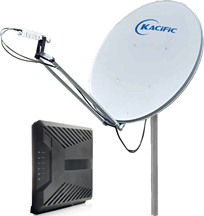Kacific: Bringing its Successful Business Model of Connecting the Unconnected to South Asia and Beyond
by Virgil Labrador, Editor-in-Chief
Dubai, UAE, May 12, 2022--The South Asian market, comprising the countries belonging to the South Asian Association for Regional Cooperation (SAARC) that include Bangladesh, Bhutan, India, Maldives, Nepal, Pakistan and Sri Lanka, is one of the world’s most underserved markets for telecommunications services. Internet penetration in the region according to the International Telecommunications Union (ITU) is only 39 percent of the population of nearly two Billion as of 2020. That’s nearly 1.2 billion unconnected people without access to broadband services.
One satellite company with a proven track record of success is hoping to bridge the digital divide in South Asia and neighboring regions that have large number of unconnected populations. Kacific, a satellite operator based in Singapore has made it its mission to connect the unconnected. Its first satellite, Kacific-1, launched in 2019 has achieved in a relatively short time providing broadband access to over 120 million people previously unconnected in the remote areas of South East Asia and the Pacific. The state-of-the-art Geosynchronous satellite with 60 Gbps of bandwidth capacity has 56 high power spot beams providing coverage to an area populated by over 470 million people. The company is now the largest provider of Ka-band satellite services in East Asia and the Pacific.
 |
| Kacific is briging its successful business model of connecting the unconnected to South Asia and beyond with it forthcoming Kacific-2 satellite. |
More than just providing broadband access, Kacific has a unique business model that is making a substantial impact on the lives of the people and communities that it serves. Kacific’s business model aims not just to achieve profitability and a reasonable return on its investment for its various stakeholders, but also to achieve Environmental and Social Goals (ESG) in line with sustainable development goals set by the United Nations. By bringing broadband access to remote communities, the impact is beyond simply accessing the Internet - the business model empowers more and more people through supporting local businesses and contributing to job creation; promoting gender equality through connecting schools by making education even more accessible; improving quality of life by connecting health facilities and bringing health care to local clinics in isolated communities, among others.
Kacific is planning to expand their unique business model of providing affordable satellite broadband internet to the underserved South Asia, the rest of South East Asia and neighboring regions with its upcoming Kacific-2 satellite scheduled for launch in 2025.
Kacific’s agile business model and innovative technology which has worked very well in East Asia and the Pacific promises to make a substantial impact on the South Asian region. For its Kacific-1 broadband satellite service offering, it has added a franchise retail model to complement its wholesale model distributing bandwidth primarily through large (Internet Service Providers (ISPs) and telecom operators. The new model was created partly in response to businesses finding it difficult to commit to long-term contracts. Kacific’s innovative franchise retail model, Gigstarter, is a pre-packaged, prepaid, monthly broadband service, which allows channel partners to resell broadband plans easily to end users plan-by-plan, site-by-site through small, light, and easy-to-install VSAT terminals. This offers many practical advantages for distributors or ISPs alike, including the hassle-free deployment of pre-packaged broadband plans with turnkey fair use policies and quality of service settings.
Another innovation to its service offering was in its distribution channel. Kacific developed a network of Authorised Distributors (KADs) in which local entrepreneurs can participate and get licensed to resell Kacific’s broadband services in remote regions. The KAD channel has created avenues and opportunities for rural economic development, further increasing Kacific’s reach and impact in the remote and isolated regions in South East Asia and the Pacific.
In the price-sensitive South East Asian and Pacific markets, Kacific has managed to reduce the total price of satellite broadband for customers with the introduction of a terminal kit consisting of low power, high throughput ST Engineering iDirect MDM2010 IP Satellite modem, its paired iLNB 3210 transceiver, and the 1.2m VSAT antenna. The MDM2010 is a 2-way, high throughput modem supporting a wide range of IP services like Internet/intranet access, VoIP and multi-casting services. Its easy point-and-play installation and high-performance modulation techniques allow Kacific to offer fast broadband services more cost-effectively over its Ka-band network.
The compact, lightweight modem is more affordable, easier to set up than existing modems, and can be configured from a web browser. It has
 |
| Kacific's terminal kit consisting of low power, high throughput ST Engineering iDirect MDM2010 IP Satellite modem, its paired iLNB 3210 transceiver, and the 1.2m VSAT antenna. |
a small profile, low power consumption and is suitable for all weather conditions. Its introduction will reduce installation time and bring down the cost of the terminal kit by up to 50 percent, with entry prices starting around US$ 400 FOB (Free on Board). The new modem will easily connect 5 to 10 average users simultaneously, making it suitable for farms, households, and small or medium businesses.
“The underlying principle of Kacific’s business is providing fast affordable broadband to under-served areas. The MDM2010, is a step forward in delivering that. Along with its paired iLNB transceiver, it is an entry level product that will significantly lower the price of Kacific’s consumer-oriented terminals without compromising performance. It is capable of speeds of up to 50Mbps down and 10Mbps up, further reinforcing the total cost-effectiveness of the Kacific broadband plans for consumer and Small/Medium Enterprise (SME) end-users,” said Christian Patouraux, Kacific’s Founder and Chief Executive Officer.
“There is nothing more satisfying for us at Kacific than to see videos of smiling users accessing rich online content for the first time via a Kacific VSAT terminal. Every life that we touch with internet connectivity represents a chance for a child, a family, a community, to have higher quality education and healthcare and be better integrated in a fast, connected world,” Patouraux added.
The upcoming satellite Kacific-2 will bring more of the innovations and best practices that its first satellite has successfully implemented in the East Asian and Pacific regions. “We are confident that the unique business model that we have implemented in East Asia and the Pacific with our first satellite, Kacific-1, will work just as well in the underserved markets of South Asia and neighboring regions. Specifically, our franchise retail model where we essentially partner with ISPs and Telco operators and sell them not bandwidth, but broadband plans that provides them the flexibility in their business. In addition, we developed a network of distributors who are incentivized to sell our broadband plans to their customers. These innovative practices which has worked very well for us, our partners and various stakeholders. It has enabled us to reach profitability in a relative short-time and provide broadband access to those unconnected and help developing communities reach key social development goals,” said Patouraux.
 Virgil Labrador is the Editor-in-Chief of Los Angeles, California-based Satellite Markets and Research which publishes a web portal on the satellite industry www.satellitemarkets.com, the monthly Satellite Executive Briefing magazine and occasional industry reports called MarketBriefs. Virgil is one of the few trade journalists who has a proven track record working in the commercial satellite industry. He worked as a senior executive for a teleport in Singapore, the Asia Broadcast Center, then-owned by the US broadcasting company CBS. He has co-authored two books on the history of satellite communications and satellite technology. He holds a Master’s in Communications Management from the University of Southern California (USC). He can be reached at virgil@satellitemarkets.com
Virgil Labrador is the Editor-in-Chief of Los Angeles, California-based Satellite Markets and Research which publishes a web portal on the satellite industry www.satellitemarkets.com, the monthly Satellite Executive Briefing magazine and occasional industry reports called MarketBriefs. Virgil is one of the few trade journalists who has a proven track record working in the commercial satellite industry. He worked as a senior executive for a teleport in Singapore, the Asia Broadcast Center, then-owned by the US broadcasting company CBS. He has co-authored two books on the history of satellite communications and satellite technology. He holds a Master’s in Communications Management from the University of Southern California (USC). He can be reached at virgil@satellitemarkets.com





